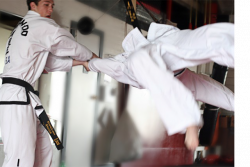Historical background
“JOONG-GUN” is named in reference to the patriot AHN JOONG-GUN who murdered Hiro Bumi Ito (the (the first Japanese governor-general of Korea).
The 32 movements of the Tul represents the age of Ahn when he was executed in Lui-Shung prison (1910).
Knowledge for the 3rd Kup
Matsogi
For the exam, the student must perform 12 SAMBO MATSOGI programs. In addition, the student’s needs to execute 10 IBO MATSOGI (two-step) demonstration and also perform 8-ILBO MATSOGI’s (one step sparing).
Hosinsul
In HOSINSUL (self-defense), there usually is a physical contact between the attacker to defender.
In defense against weapons there usually is a physical contact of the defender against the attacker.
We divide hosinsul into two parts:
-
-
- Physical contact attacker
- Forward with weapons
-
Therefore, ITF Taekwondo is a modern sport considering all possible defense techniques such as long distance (legs), medium range (arms, elbow, knee) or close combat (throwing, extrication, vital points).
Note: It is always possible that one is faced with a very strong opponent. Here are two solutions:
-
-
- Use your speed and a rotational movement.
- Hit the opponent on a painful place.
-
Physical contact attacker
The opponent holds. Three possibilities:
-
-
- Offensive movement: attacks with stroke or stamp on a vital place or vulnerable body spot.
- Breaking movement: on the attacking limb.
- Liberation movement: a twisting motion followed by counterattack.
-
Attack Situations
-
-
- standing
- kneeling
- lying
- sudden attack of opponent
-
Throwing and falling techniques
Falling is an art, take into account these rules :
-
-
- Relax Body
- Try to fall on your side, not your front or back.
- Safely absorb the shock with the palm of the hand on the ground.
- avoid hitting the head.
- Legs high.
-
Don’t just throw your opponent to the ground during training, you do not want to hurt him.
Ground Principle: make opponent off balance. Possibilities:
-
-
- Standing
- Kneeling
- Lying
-
Attacker with weapons
You are attacked with a weapon (s). Dodging is the most appropriate move, but you’re not safe enough.
Try to let the opponent make an additional “step”. To be so close to him (or to the weapon according to your placement) makes it easier to finish your counterattack.
Pihagi (= evade, avoid) is important. Left or right, but not back in line. Block against the arm or hand, but not against the weapon (don’t touch the weapon when blocking, especially when blocking knives).
Hand technique for 3rd Kup
| Korean | English |
| SONKAL DUNG KAUNDE BAKURO MAKGI | Reverse knife-hand middle reverse block |
| SONDABAK BANDAE OLLYO MAKGI | Palm upward block |
| WI PALKUP TAERIGI | Upper elbow strike |
| SANG JOOMUK NOPUNDE SEWO JIRUGI | Twin fist high vertical punch |
| SANG JOOMUK DWIJIBO JIRUGI | Twin fist upset punch |
| KYOCHA JOOMUK CHOOKYO MAKGI | X-fist rising block |
| DOO PALMOK NOPUNDE MAKGI | Double forearm block |
| SONDABAK BANDAE NOOLLO MAKGI | Palm pressing block |
| KYOCHA JIRUGI | Front forefist angle punch |
| DIGUTJA MAKGI | U-shape block |
Position for 3rd Kup



